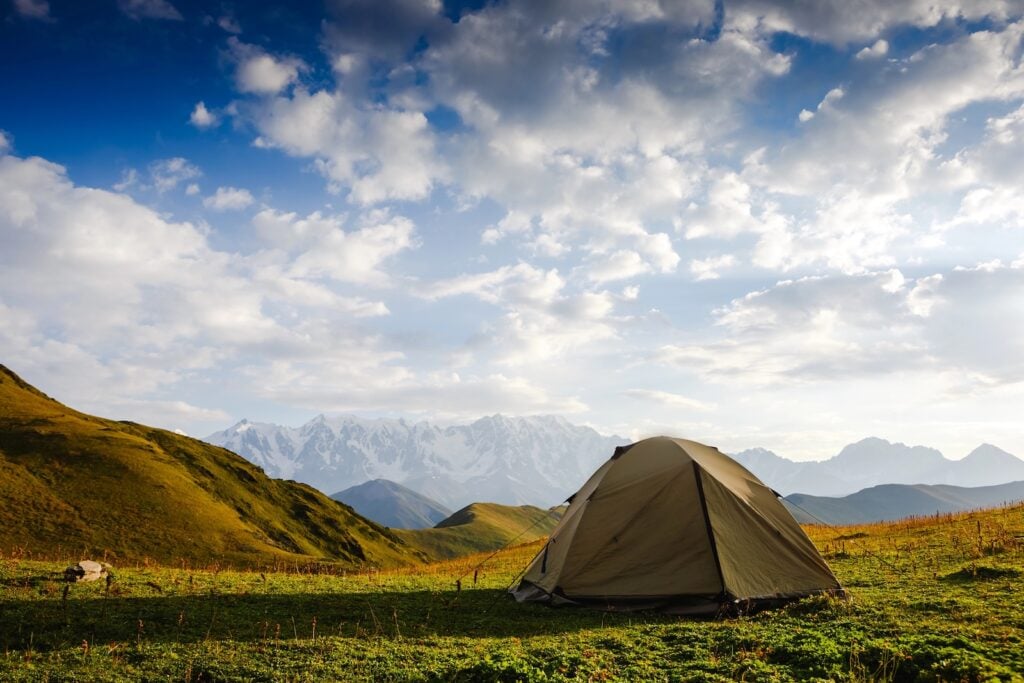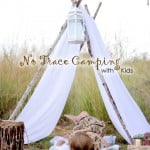No Trace Camping: Eco-Friendly Camping Tips
Camping is a fun and memorable way to help children fall in love with nature. When we immerse them in the sounds, smells, and stillness of the natural world, we’re raising a new generation of thoughtful environmental stewards.
By following the principles of Leave No Trace camping, you set a lifelong example of how to enjoy nature without leaving waste or damage behind.

Exploring nature, cooking over an open fire, and sleeping under the stars is the classic summer tradition families have shared for generations.
While some of the ways we camp have changed, such as staying in a yurt rather than a tent, or taking a mobile camping trip in an RV, one principle has remained steadfast. Preserve what is here so it is available for years to come.
As you plan your next camping getaway, consider these eco-friendly camping tips to help teach them the importance of preservation.
What Is Leave No Trace Camping?
The principle of “Leave No Trace” camping is just how it sounds: leave no trace you were ever there so future visitors can enjoy the same untouched beauty.
Whether you’re backpacking into the wilderness or driving up to a local campground, Leave No Trace (LNT) is a framework you can apply anywhere. It teaches kids that nature isn’t just a backdrop, it’s a living, breathing system that deserves respect.
Here are the 7 principles established by the Leave No Trace Center for Outdoor Ethics:
• Plan ahead & prepare
• Travel & camp on durable surfaces
• Dispose of waste properly
• Leave what you find
• Minimize campfire impacts
• Respect wildlife
• Be considerate of other visitors
How to Teach Kids Leave No Trace Camping (No Lecturing Needed)
Let’s be honest: no kid wants a checklist read to them around the campfire. But when you turn these principles into fun and meaningful habits, they stick.
Here are some simple, doable ways to practice no-trace camping as a family:
Pack It In, Pack It Out
Everything you bring in should go out with you. This includes the random things kids tend to drop (fruit snacks, hair ties, game pieces, etc.).
Common items left behind that people think the next camper will use include half empty propane cylinders, clotheslines, and bug spray. Save them for your next nature outing.
Bring plenty of reusable bags and teach kids how to do a quick “micro cleanup” before leaving the site. It can even become a game: Who can find the most left-behind pieces before we go?
Be Fire-Wise
Always use designated fire pits. Don’t try to make your own, even if it seems harmless. And check campground rules. Some prohibit fires during dry seasons or require you to buy firewood locally to avoid spreading invasive pests.
Never cut your own wood in the park. Teach kids that fallen branches and trees are part of the forest’s life cycle and shelter for wildlife.
Use Eco-Safe Soap & Water Practices
Most campers pour dishwater or shampoo suds into the bushes without thinking twice. The problem is, many conventional products contain chemicals that pollute waterways and harm wildlife.
Use certified biodegradable soaps, and do all washing at least 200 feet away from streams or lakes. Let kids help with the “camp dish station” and explain how what we wash affects the frogs and fish nearby.
Look, Don’t Take
With the abundance of beauty in nature, it can be tempting to bring home a small token from your trip such as a flower, leaf or rock. However, it’s important to remind yourself and the kids that if everyone were to bring something back, there wouldn’t be any beauty left.
Enjoy nature while you’re there, but don’t take it with you when you leave. For example, you can enjoy the beautiful trails at national parks or campgrounds, but don’t disturb any natural habitats by picking flowers along your way.
Instead, encourage observation. Let them draw what they see in a nature journal, or take photos for a “wild wonders” collage when you get home.
Bring Reusable Gear
While paper or plastic dishes and utensils may seem like a great way to pack light, the impact those have on the environment lasts for years. Instead of throwing away a mountain of paper or plastic at the end of your trip, bring, use and reuse camping gear that will last.
Collapsible dishes take up significantly less space and are much simpler to store when not in use. Plus, the dishes usually come in bright, vibrant colors and are easy to find as you’re packing up the campsite (even after being left 30 feet from the campsite by the kids).
And when it comes to staying hydrated, consider refillable bottles with built-in filters. They cut down on plastic and let you refill from park taps or clean streams.
Buy Secondhand or Borrow What You Can
Camping gear can be a big investment, especially for growing families. But it doesn’t have to be.
Check local resale groups, Facebook Marketplace, REI’s used gear section, or GearTrade.com for pre-loved tents, sleeping bags, and backpacks. It’s a great way to save money and keep gear out of landfills.
Even better? Borrow from a friend or neighbor for your first trip. Many communities also offer outdoor gear lending libraries.
Get Kids Involved in the Adventure
Leave No Trace doesn’t mean less fun—it actually makes camping more interactive when you include kids in the planning and care of your trip.
- Let them help pack their own gear (with guidance).
- Create a nature scavenger hunt with things to spot, not collect (chipmunk, pinecone, feather, cloud shaped like an animal).
- Encourage them to explore by bike or foot – free-range time builds confidence and curiosity.
- Ditch the stroller and bring a babywearing carrier. You’ll enjoy the park more without the constraints of a stroller.
- Campgrounds with nature programs or junior ranger activities are great for learning through play.
What If You’ve Never Camped Before?
You don’t need to backpack deep into the wilderness to enjoy a no-trace experience. Many local, state, and national parks offer clean, safe, beginner-friendly campgrounds, often with bathrooms and fire rings ready to go.
Start with a one-night stay at a local campground or even your own backyard to ease into the experience.
Yurts, tiny cabins, and glamping setups are perfect if your crew isn’t quite ready for tents.
The Real Gift: Lifelong Memories & a Love of Nature
The sound of a creek, the scent of the trees after a rainstorm, the joy of roasting marshmallows under a starry sky… these are the moments your kids will remember.
No trace camping has a way of grounding us, stripping away distractions and reconnecting us with what really matters.
No matter where or how you’re camping this summer, keeping these tips in mind will help ensure your children, grandchildren, and generations beyond can enjoy the outdoors. Whether you’re on the coast of the Pacific Northwest, in the middle of a birch forest in Wisconsin or on a crystal clear lake in Texas, eco-friendly camping is a great way to keep natural beauty available for all.
Camping should be fun, and it doesn’t have to feel like “roughing it” unless you choose. Camp in the style that works best for your family and remember to stop and enjoy the smells and sounds that surround you. The simplicity of it all is bound to stay with you and your kids for a lifetime.


Great blog. I definitely agree with this. We need to save nature for generations to come.